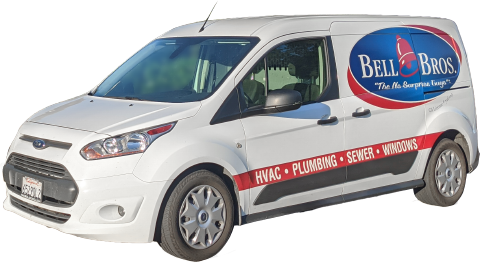Your HVAC System and Your Health: Does Your Stockton Home Have Sick Building Syndrome?
It’s common to feel a little under the weather this time of year. They don’t call it “cold and flu season” for nothing! It’s also common for people in the same house to feel unwell at the same time; that’s how disease often spreads. But did you know that buildings can get sick as well? And that the symptom of a “sick building” is perpetually sick people inside that building? If that doesn’t makes sense, don’t worry, it will: today we’re going to talk about your HVAC system and its role in your health and wellness.
Sick People
A cold is one thing. We get them, and usually they go away pretty quickly. But sometimes they stick around for weeks at a time. We’ve had those colds that linger all winter, waiting for spring before they finally clear up. But if flu-like symptoms last for months, the solution may not lie in a doctor’s office–especially if they seem to clear up and then come back again.
These symptoms include coughing, headaches, nausea, dizziness, fatigue, nose and throat irritation, and other symptoms that we usually write off as “having a cold.” But the doctor may be baffled, unsure why your illness persists and sometimes subsides. That leaves you baffled as well. Why is it so hard to diagnose a common cold? Why can’t you get it treated? Why does it last so darn long? The answer may be simple: You’re not sick, your building is sick!
Sick Building Syndrome
At this point you probably think we’re pulling your leg. But in the words of Levar Burton, you don’t have to take our word for it: The National Center for Biotechnology Information lists “Sick Building Syndrome” as a relatively common occurrence. The signs are occupants of a building suffering from flu-like symptoms but without appearing to have illnesses or other explanations for those symptoms.[1. https://www.ncbi.nlm.nih.gov/pmc/articles/PMC2796751/]
Duration and location are the important factors in determining if your home is “sick” or not.[2. https://www.aafa.org/display.cfm?id=9&sub=18&cont=380] If you always feel unwell in a particular building (like your home) but the symptoms get better when you go elsewhere, the building itself may be the problem. And if those symptoms persist for months at a time every time you go into the building and spend time there, it’s even more likely that the building has an issue.
Like the common cold or flu, buildings can become sick for a number of reasons. Causes could include indoor or outdoor chemical contaminants, biological contaminants (like mold and mildew), and asbestos. Any one of those (or a combination of them) can affect your respiratory system, irritate your eyes and nose, and make you feel unwell. Mold is a pretty common cause here in the valley, but we’ve dealt with HVAC systems that were piping nasty smog through moldy filters, and failing to ventilate the room properly. One poor client was at her wit’s end when she called us to fix the issues–she’d been feeling ill for months, and was frustrated when taking sick days didn’t seem to help her get better. And no wonder–her home was the problem!
Any of these problems will be exacerbated by poor or inadequate ventilation. If the air isn’t being moved through the house, it’s probably also not being filtered properly. And a bad HVAC system can fill a room with contaminants quickly, especially if that room isn’t set up to vent pollutants back out again. If your rooms feel dank, damp, or stale, your ventilation system may not be working correctly or may be inadequate to suit your home’s needs. It may also be affecting your health in a negative way.
Making a Sick Building Well
Having an HVAC tech check out the building is always the first step. They’ll go down the list of possible causes, looking for each and finding ways to improve the situation and fix the problem. They’ll be able to tell if a building is “sick” with interior contamination or is allowing in outside allergens and contaminants that are taking a toll on the occupants’ health. They’ll also start the ball rolling on possible solutions, working with the homeowner every step of the way to ensure their comfort with the process and take into consideration any concerns the homeowner may have.
Fortunately, many of the solutions to sick building syndrome are as simple as mold-clearing or asbestos treatment. They could even be as simple as changing the filters and servicing the system to remove allergens or contaminants.[3. https://www.achrnews.com/articles/88358-allergies-asthma-and-the-role-of-hvac] Keep in mind that your HVAC system pulls air from a relatively small area outside your home (usually the outside AC unit). Often, that small area may be overgrown with plants or subject to chemical use. One example that always comes to our mind is the client whose HVAC system was pulling in pesticides fresh from the garden–talk about bad for your health!
Other solutions may require more in-depth HVAC work, like re-ventilating part (or all) of a house to achieve adequate air flow. Many homes were built to conserve energy at a time (the 70s and 80s) when that science was in its infancy, and poorly-ventilated homes were an unfortunate side-effect of those well-meaning attempts. If that’s the case with your home, your HVAC contractor will let you know what steps to take–usually with a few different options depending on how far you want to take the process.
No matter what the cause, there is a solution. Just like a human cold, if your home is sick we’re here to help. We never wanted to be doctors, but as far as your HVAC system is concerned we’re highly-trained surgeons ready to go to work! Give Bell Brothers a call if you’re feeling under the weather, because it might not be you at all!

